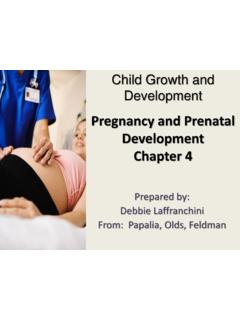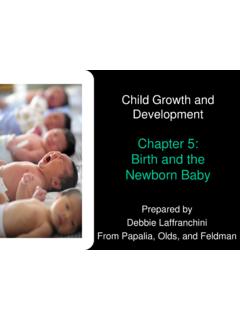Transcription of 5. OBSERVING, RECORDING, AND REPORTING …
1 , RECORDING, ANDREPORTINGCHILDREN'SDEVELOP MENTO bservingandRecordingHowdoteachersknowif thematerialsintheactivitycentersareofint eresttochildren?Howdotheyknowif theactivitiesaremeetingtheneedsofchildre n?Howcanteachersshareinformationwithpare ntsina waythataccuratelydescribeshowtheirchildr enarespendingtheirtime?Howdoteachersdocu menta concernthattheyhaveabouta child'sbehavior?Howdoteachersindividuali zeanactivity?Thesearesomeofthequestionst hatteachersshouldaskthemselvesastheyplan activities,adapttheenvironment, ,classroom, , ~a ' bigsmilemightbetheonlyindicationwehaveth ata ,Childrencommunicatewithusthroughtheirey es,thequalityoftheirvoices,theirbodypost ures,theirgestures,theirmannerisms,their smiles,theirjumpingupanddown, ,bythewaytheydothings,aswellasbywhatthey do,whatis 'sbehaviorthroughtheeyesofitsmeaning99 OBSERVING, RECORDING, andReportingChildren 'sDevelopmenttothem,fromtheinsideout, (CohenandStem,1974, ).
2 Byrecordingtheirobservations,teachersdoc umentchildren' ,observationsofthechildcanrevealpatterns ofbehavior,learningpreferences,masteryof skills, , ,however,todescribeaccuratelythebehavior stheyrecord, ;rather, :"Jopickeduptheblockandthrewit atSamuel,"or,"Mariespenthertimeoutdoorss ittingunderthetree."Subjectiveobservatio nsarelabels,judgments,orinformationrecor dedoutofcontext:"Jois aggressive"or,"Marieis lazy."Labelsdonotconveyinformationthathe lpsinunderstandinga child' ,record-ing"Adamchosetobuildwithblocksin theblockarea," doesnotprovideasmuchinformationasthefoll owing,morecomplete,anecdotalobservation: "AssoonasAdamcameintotheclassroom,heanno uncedtohisfriends,MicaandSol,thathewante dto'buildthebiggesthouseinthecity.' sign100 OBSERVING, RECORDING, andReportingChildren 'sDevelopmentforhishouse,whichI ,'TheBigHouse.'Adamstayedintheblockcente rforfiftyminutes.
3 " ,sharedhisideas, )',hesustainedattentionfora long, , ,whenit happened,whereithappened,thestimulusfort heactivity,thechild'sreactions, ' ,examin-101 OBSERVING, RECORDING, andReportingChildren ' , 'snoserunningorstuffed?Doesthechildseemf lushedorfeverish?Is therea rash?Anybruisesorlacerations?Areeyestear fulorrunning?Is thechildscratchingherhead?Isthechildhear ingwell,ormighthisearsbefilledwithfluid? Isthechildlimping?Doesthechildhavediarrh ea?If thechildis unwell,theteachershouldlettheparentsknow immediatelyandkeepthechildquietandawayfr omotherchildrenif , child' ,expressiveandreceptivelanguage,intellec tual,social-emotional, developmentalchecklist,ObservationCheckl istforTeachers, recordofwhatlearningcentersthechildrench oose, ,forexample, favoriteartactivityinanotherpartoftheroo m,suchaspaintingcloudsandtheskyfora teacherkeeptrackofthenumberoftimesa specifiedtime("Suehitanotherchildfivetim esduringoutdoorplaytoday,")orthelengthof timea behaviorlasted("Thomascriedforeightminut eswhenhewasaskedtowashupforlunch.
4 ")Theserecordscanbeusedtohelpa childreduceordiminisha ,iftheteacherdiscoversthatThomascrieswhe nevertherearetransitionsfromoneactivityt othenext, effectiveonlyif thebehavioris , RECORDING, andReportingChildren'sDevelop mentPortfoliosorWorkSamplesThesearecolle ctionsofworkthata ,dictatedstories,attemptsatwritingwordsa ndnumbers,andlanguagesamples,whicharetra nscriptionsoftheex-actwordsa childusestoexpressa ,a seriesofphotographscanprovidea child' andwhatit ' ,ideas,andworkwithadultsif teachertakestimetolistentoa childdescribeanartprojectortalkabouta favoritecousin,it ,suchas"Whyarecloudsinthesky?"or"Howdoes anairplanefly?"provideinsightintotheleve lofthechild' ,suchas,"Howarebirdsandairplanesalike?" tolearnmoreabouta child' ,writing,andspeaking, childwhoanswersthequestion"Howdoyouknowh owtoreadwords?"with"Wordsarereallylotsof lettersthateachhavea sound,andyoumoveyourtongueandlipsinfunny waystomakethesounds,"maybereadyforrhymes andbookswitha "Wordsarelikepicturesthatgrown-upsknow," ,playwithlettersandnumbersina moreconcreteway, ,where, , , RECORDING, andReportingChildren'sDevelop mentRecordingTechniquesandToolsTeachersu sea tokeepa padofpaperandpencilina pocketatalltimestocatcha ,theseshortnotesaretranscribedingreaterd etailintoa , a teacherwantstoobservegrossmotordevelopme nt,shecansetupanobstaclecourseoutsideand usea developmentalchecklisttorecordtheskillso fallthechildr~astheyplayonthebalancebeam ,climbstairs, , recording , is.
5 FamilyCultureandDiversityThemostsalientc haracteristicofeachfamilyis , ,suchasdietarypreferences(porkmaybeprohi bited),religiouspractices(Hanukkahcanbec elebratedalongwithChristmas),language(th echildmayspeaka differentlanguageathome),andtime(somecul turesviewtimeasflexible).Teacherswillals ohavea , RECORDING, andReportingChildren'sDevelop mentSomefamiliespreferthatchildrenbe"see nandnotheard," ~ ,mostfiveyearoldchildrencanconcentratelo nger,communicatemoreeffectively,engagein moreinteractivepla~ animportantfactorwhende-terminingwhatact ivitiestoprovide,howtoprovidethem,andfor howlong.(SeeDevelopmentalGuidelinesinCha pter2).DevelopmentalLevelWithinanygroupo fthree-year-oldchildren, ; ,thedevelopmentofchildrenisoftenuneven:a childmaybeadvancedinlanguageandcommunica tion, thereareparticularlygiftedordevelopmenta llydelayedchildrenintheclass, is,therefore,notenoughtoconsiderchronolo gicalagealone.
6 Toindividualizeeachlearningstrategy,thet eachermustalsoconsiderthechild' a : Serious/Lighthearted Energetic/Calm Extroverted/Introverted Curious/Indifferent Easygoing/Intense Fastidious/Messy Risk-taker/Cautious , , RECORDING, andReportingChildren'sDevelop mentTolearnwellsomechildrenneedtotalkand interactwithothers, ,forexample, , ,suchasboysengaginginloud,physical,rough -and-tumbleplayandgirlspreferringlanguag e-based,social, is naturaltoallowchildrentoselectplaymatesa ndactivities,evenif notnecessarilyanindicationofintelligence , , childhasa ~tactile, , childis , ,othersbydinosaurs,a certainsport,ora , ,soit is , RECORDING, andReportingChildren'sDevelop mentStrengthsandNeedsAllchildrenhavestre ngths(whattheydoparticularlywell)andneed s(whattheyrequirehelpwithtodobetter). ,whichareoftenthesame, , ,thenhashermixthepaintsusinga , ,howrealis-ticallytheyknowtheirownstreng thsandneeds,andhowtheyjudgetheirownabili tytoundertakea ,othersasextremelyca-pable, ,oroveresti-matingone'sabilitytoaccompli sha taskisjustasproblematicasa realisticsenseofthemselvesandteachthemto identifyresourcestosolveproblems(animpor tantpartofself-efficacy)if theyareabletodetermineaccuratelythata particulartaskis toodifficultfora : Howa childrespondstoroutines.
7 Howa childmanagestransitions,quietandactivepe riods, ,duringmealtimes,usingthetoilet,dressing ,washing, , RECORDING, andReportingChildren'sDevelop ment (Isthebrushheldsecurely?),thevarietyofma terials(Doesthechildusealltheartsupplies oronlythepaintsat theeasel?),theimaginativeuse(Doesthechil dinventnewwaystousethesmallblocksoralway sstackthem?),skilllevel(Howmanypiecesare inthepuzzlesheputstogether?),andconceptu nder-standing(Howcomplexisthemathematica lthinkingthatisdemonstratedasthechilduse sattributeblocks?). Howa Howa lotofattentionordirection?Doesthechildas kforconstantpraise?Doesthechildenjoytalk ingwiththeteacher?Doesthechildspendtimew ithadultvisitorsintheclassroom? Howa hisvocabulary? Howa ,run,skip,jump?Howis hisbalance?Is sheabletocatchandthrow?Is hesureortentativeinhismovements?Doesheen joysoccer,kickball,dance,andmovementacti vities?
8 Sheabletoexpressherfeelings108 OBSERVING, RECORDING, andReportingChildren 'sDevelopmentverbally?Canhenegotiatewith childrenandadults?Isheeasilyfrustrated? Therolesthechildtakeswithinthegroup(fore xample,leader,follower,listener,talker). Teachers'observations,assessmentdata, togatherinformationthatwillenabletheteac hertostructureclassroomexperiencestobett ermeetthechild' :BuildingonInterestsFora childwhois reluctanttotakerisksbyexpandingherrepert oireofactivities,theteachercanexpandafam iliaractivitybyintegratinga ,paper,andtapetotheblockareaandasksTalto makea trafficsignora "DoNotDisturb" isdifficulttohearherina friendandasksthatthepuppetsyellouta refrainina childwhodoesnotgraspa conceptwithanotherchildwhohasrecentlymas teredit ,a childwhohasnotmasteredone-to-onecorrespo ndencewatchesashisfrienddemonstratesand" teaches" , ,whenchildrenplaywithpuzzles, ,theteachercanaskonechildtoperforma hardertasksuchashoppingononefoot, , RECORDING, andReportingChildren'sDevelop mentTargetingSpecificNeedsA teachermayprovideopportunitiesfora childtopracticemasteringa a teacherhasobservedthatseveralchildrenhav edifficultyusingscissors,shemayplanactiv itiesthatusesmallmuscles.
9 Suchasfishingforobjectswithtongsorplacin gpegsina board,thenmovetotearingpaperand,finall)' , )',a teachermayfinda worrisomepatternofbehaviorthatdoesnotsee mtoimprove, , physician,psychologist, discipline,suchasa specialeducator,psychologist,speechandla nguagepathologist, ,andwithsupportfromteachersandparents,ch ildrenwithdisabilitiescanthriveina classroomthatvalueseachchild' , ' 'sdisabilityaswellasspecifictechniquesth atcanbeusedtomeettheirchild' ' , RECORDING, andReportingChildren'sDevelop mentWithparentalpermission,specialistssu chasspeechorphysicaltherapistscanobserve a childwitha disabilityina ,adaptions,andmodificationswillhelpteach ersmeetthevariedneedsofchildrenwithdisab ilities: PhysicalDisabilitiesTheclassroommayhavet obemodifiedtoaccommodatea ;aneaselcanberaised;a watertableputonblocks;bolstersmayhelpa childsitorlayina ;usetapetocreatea bettergriponpaintbrushes;havepuzzleswith knobsonthepiecesforeasyremoval;useadapti veutensilsif available.
10 , HearingImpairmentsIfthechildusessignlang uage, ,photos, ' LowVisionorBlindnessUsematerialsthatappe altomanysenses:forexample,usesandpaperle ttersandnumbers, 's111 OBSERVING, RECORDING, andReportingChildren ' belltogetthechildren' , quietareaoftheroomthatthechildcanuseforw orkthatrequiresconcentrationorfora placetorest. ,stuffedanimals, ,therearetimeswhena conferenceisusuallytoallowteacherstodisc ussthechild'sprogressandgivetheparentsan opportunitytosharetheirobservations,idea s, , RECORDING, andReportingChildren'sDevelop mentbesetforchildren,andparentscanprovid einformationonstrategiestheyuseeffective lyat , RECORDING, andReportingChildren'sDevelop mentGuidelinesforSuccessfulParentlTeache rConferences Scheduleconferencesata ,askforit specificallyandgiveanexample. TheFamilyRoomortheclassroomwillofferfami liesa 'sprogressanddevelopment.




